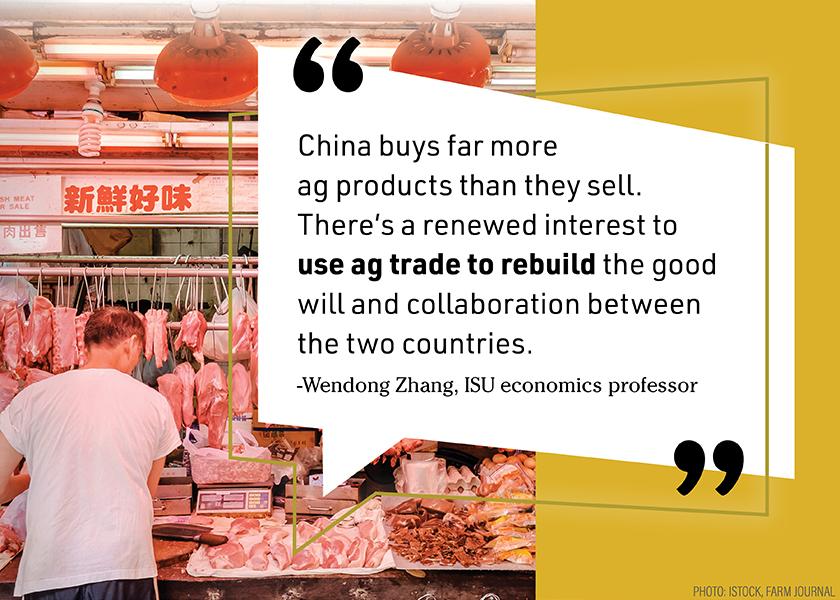Two Reasons to Keep U.S. Tariffs on Chinese Imports

Milken Institute in Los Angeles, Calif. hosted U.S. Trade Representative (USTR) Katherine Tai last week for a discussion with Host Kai Ryssdal on America’s current trade efforts in China, as well as the outlook for international trade.
In the first three months of the quarter, China’s GDP grew 4.8%, compared to the same period last year. However, with roughly 25 million Shanghai residents feeling the effects of a new lockdown, production is likely to be slow and ripple through the supply chain.
On April 27, 2022, China formally announced an extension for Section 301 retaliatory tariff exclusions on 11 agricultural products including alfalfa, whey and flour until Nov. 30, 2022. The announcement comes on the heels of China’s large sum purchases of U.S. corn, with its most recent purchase of 1.088 million metric tons.
While China imports U.S. commodities, trade liberalization continues to be USTR’s focus, according to Tai. She maintains the U.S. trade stance with China is “especially difficult”, but her team isn’t willing to play the increased tariff card, nor reduce them. However, she says those cards remain on the table.
Globalization 1.0 v. 2.0
China was the first country to impose travel bans and lockdowns during the initial rise of COVID-19. With the lockdowns came a halt in trade and production, “exposing globalization 1.0,” according to Tai.
“With China under lockdown again, we know that these [supply chain] effects are going to ripple across the global economy. This ‘globalization 1.0’ is built on the notion that trade liberalization leads to the promised land,” says Tai. “Where we find ourselves is not the promised land, but in a state of feeling global fragility and a heightened sense of insecurity."
However, Tai has high hopes for the next chapter for the U.S. that will set the trade stage with China—globalization 2.0.
“In the new version of globalization, our firms and governments need to be focused on decision making and behaviors where we’re all incentivized to reward and build resilience,” she says. “That means more choice, less vulnerability and ultimately to be better prepared because you don’t know where that next crisis is going to come from.”
The Tariff Tally
In July 2018, the U.S. and China and embarked on a trade war that continues to play out through a Phase One trade deal, which included various tariffs on both sides of the fence. As the office of the USTR weighs the future of a revamped Phase Two deal, Ryssdal begged the question as to why Tai's team elected to continue use of the Trump administration’s Phase One tariffs rather than develop their own.
Tai explained there are two reasons to keep the Phase One agreement intact:
1. Firm behaviors in both countries, as well as China’s overall behavior have changed for the better.
2. Wishing for pre-COVID-19 trade movement will not solve current supply chain issues.
Tariffs will remain a part of the U.S., China trade mix in the future, predicts Wendong Zhang, Iowa State University economics professor. But he says it’s more important to consider what China wants out of these negotiations.
According to Zhang, China likely seeks:
1. Formal removal of Phase One tariffs
2. Collaboration in agricultural technology
3. Transparency in how the U.S. reviews Chinese foreign investment.
Jim Wiesemeyer, Pro Farmer policy analyst told AgriTalk Host Chip Flory he believes Tai doesn’t want to lighten tariffs on China because she sees them as a “lever” in trade negotiations. Wiesemeyer says some don’t agree with Tai’s tactics. (The China discussion starts 15 min. into the podcast.)
“There are others in the White House who say lowering the tariffs could help in the inflation battle in a number of areas,” he says. “We still don’t have the final result of the tussle within the Biden administration, but I was told we can see something happen in regard to tariffs by the middle of June.”
Ag Trade as a Political Pawn
In 2009, President Obama stamped imported Chinese tires with a 35% tariff. In turn, China retaliated with poultry export tariffs, according to Zhang. He says this past example holds a valuable lesson.
“China buys far more ag products than they sell,” Zhang says. “There’s a renewed interest to use ag trade to rebuild the good will and collaboration between the two countries. There are many things that can be done for trade, but ag trade isn’t influenced by what happens within the borders—it’s more the political, international relations that farmers face most.”
More on China:
> 5 Trends Happening In China That Will Affect Your Farm
> How Will 400 Million People in China's Lockdown Affect Global Markets?
> China is in Hoarding Mode Right Now, And It's Pushing Grain Prices to Historic Highs







